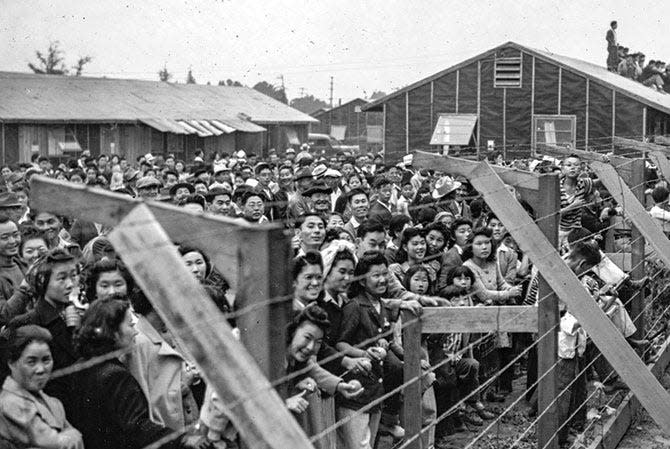Bill aims to raise awareness of history behind WWII Japanese American internment camps
- Oops!Something went wrong.Please try again later.
U.S. Rep. Jay Obernolte (R-Big Bear Lake) introduced a new bill on Thursday that would protect and promote the history of Japanese American internment during World War II.
The bill would include a new network of historic sites administered by the National Park Service, including the Manzanar Relocation Center.
The bill, HR6434, has gained rapid traction in the U.S. House of Representatives, with a hearing already scheduled for Feb. 3 in the House Natural Resources Committee, according to Obernolte’s office.
“The history of Japanese American internment during World War II runs through the Western United States from the Manzanar Relocation Center in Inyo County to assembly centers scattered across our state of California. It is a tragic part of the life stories of the thousands who lost their liberties in the face of fear and uncertainty, and it is a part of this nation’s history that must be told,” Obernolte said. “The power of history is to gain perspective and learn from our past. By bringing transparency to the story of Japanese American internment, we can ensure such injustice never again occurs within our country.”

The Japanese American World War II History Network will provide a platform to increase access and promote heritage tourism to federal, state, and privately owned sites linked to Japanese American internment during World War II.
This would significantly improve awareness for potentially hundreds of sites across the U.S. and help to tell the stories of the more than 120,000 Japanese Americans who faced discrimination, involuntary relocation, and confinement during the war.
Using the model of existing networks, including the African American Civil Rights Network, the Underground Railroad Network to Freedom, and the Reconstruction Era National Historic Network, the National Park Service would create a map showing locations on the network, a brief history of each site and information on whether sites are open or closed to the public.
Users will be empowered to use an interactive map to explore different areas, learn about the journeys of Japanese Americans during World War II and plan visits to historical and cultural sites.
The internment camps
In reaction to the Pearl Harbor attacks in December 1941, Japanese internment camps were established during WWII by President Franklin D. Roosevelt.
The camps came via Roosevelt's Executive Order 9066 to protect the U.S. “against espionage and sabotage” by those of Japanese descent living in the U.S., according to the National Archives.
The U.S. government’s policy that for three years, beginning in 1942, people of Japanese descent, including U.S. citizens, would be incarcerated in camps.
Ten war relocation centers were built in remote deserts, plains, and swamps of seven states, including Arkansas, Arizona, California, Colorado, Idaho, Utah, and Wyoming.
The internment camp at Manzanar was located in the Owens Valley of California between the Sierra Nevada on the west and the Inyo mountains on the east, according to the NPS.
In California, the Tule Lake camp held persons of Japanese descent removed from western Washington, Oregon, and Northern California.
Located near the Oregon state line, Tule Lake was the largest of the camps, and the only one converted into a maximum-security segregation center, the Tule Lake Committee reported.
All Japanese Americans within varying distances from the West Coast were targeted. Unless they could make arrangements for care of their property, their homes, farms, businesses and most of their private belongings were lost forever.
Canada soon followed suit, along with Mexico. Thousands of people of Japanese descent were also forcibly removed from Peru, Brazil, Chile, and Argentina to the U.S.
Daily Press reporter Rene Ray De La Cruz may be reached at 760-951-6227 or RDeLaCruz@VVDailyPress.com. Follow him on Instagram @RenegadeReporter and Twitter @DP_ReneDeLaCruz
This article originally appeared on Victorville Daily Press: WWII Japanese American internment camps: Preserving their stories

